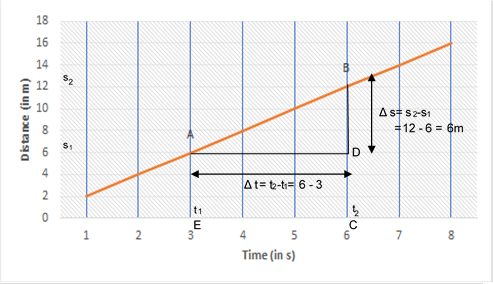Distance Time Graph For Uniform Motion







Distance Time Graph For Uniform Motion
The change in the position of an object with time can be plotted on the distance - time graph by choosing a scale best suited. To draw distance-time graph, time is plotted along X-axis and the distance of the body is plotted along Y-axis.
In this case, the slope of the distance-time graph is equal to the speed of the object.
Distance - Time graph for Uniform Motion
If an object travels equal distances in equal intervals of time, then it moves with uniform speed. For uniform speed, a distance- time graph represents a straight line.
|
From the graph, it is clear that in equal interval of time 2s, the object covers equal distance 4m, so the motion is uniform and graph is a straight line. Calculation of speedTo calculate the speed of the object from a distance-time graph, we calculate the slope of the line. The slope is defined as the ratio of change in the value of y with the change in the value of x because the change in y represents the distance and change in x represents time. Ratio of distance with time represents speed. To find the change in x and y we choose any two points say A and B on the straight line. From points A and B, draw perpendicular AE and BC respectively, on time axis. the difference of the value represented by Point C and E represents a change in time.From points A draw perpendicular AD and BC. The difference of the value of distance at point B and D represents a change in distance. The distance traveled by the object from point A to B is = BC - DC = Time taken by the object to cover this distance = OC - OE = |
 |
ILLUSTRATION : The graph below shows the positions of a body at different times. Calculate the speed of the body as it moves from
(i) A to B, (ii) B to C and (iii) C to D.
|
SOLUTION: (i) For the motion from point A to B, time taken, t= 4 -1 = 3 s Distance covered = 8 - 2 = 6 m (ii) For the motion from point B to C, time taken , t = 7 - 4 = 3 s Distance covered = 8 - 8 = 0 m (iii) For the motion from point C to D, time taken, t = 10 - 7 = 3 s Distance covered = 17 - 8 = 9 m |
 |
Students / Parents Reviews [10]
My experience with Abhyas is very good. I have learnt many things here like vedic maths and reasoning also. Teachers here first take our doubts and then there are assignments to verify our weak points.

Shivam Rana
7thAbout Abhyas metholodology the teachers are very nice and hardworking toward students.The Centre Head Mrs Anu Sethi is also a brilliant teacher.Abhyas has taught me how to overcome problems and has always taken my doubts and suppoeted me.

Shreya Shrivastava
8thI have spent a wonderful time in Abhyas academy. It has made my reasoning more apt, English more stronger and Maths an interesting subject for me. It has given me a habbit of self studying

Yatharthi Sharma
10thAbhyas is a complete education Institute. Here extreme care is taken by teacher with the help of regular exam. Extra classes also conducted by the institute, if the student is weak.

Om Umang
10thIt was a good experience with Abhyas Academy. I even faced problems in starting but slowly and steadily overcomed. Especially reasoning classes helped me a lot.

Cheshta
10thMy experience was very good with Abhyas academy. I am studying here from 6th class and I am satisfied by its results in my life. I improved a lot here ahead of school syllabus.

Ayan Ghosh
8thIt was good as the experience because as we had come here we had been improved in a such envirnment created here.Extra is taught which is beneficial for future.

Eshan Arora
8thA marvelous experience with Abhyas. I am glad to share that my ward has achieved more than enough at the Ambala ABHYAS centre. Years have passed on and more and more he has gained. May the centre flourish and develop day by day by the grace of God.

Archit Segal
7thMy experience with Abhyas academy is very good. I did not think that my every subject coming here will be so strong. The main thing is that the online tests had made me learn here more things.

Hiya Gupta
8thAbhyas Methodology is very good. It is based on according to student and each child manages accordingly to its properly. Methodology has improved the abilities of students to shine them in future.
